The NVIDIA GeForce GTX 780 Ti Review
by Ryan Smith on November 7, 2013 9:01 AM ESTOverclocking
Finally, let’s spend a bit of time looking at the overclocking prospects for the GTX 780 Ti. Although GTX 780 Ti is now the fastest GK110 part, based on what we've seen with GTX 780 and GTX Titan there should still be some headroom to play with. Meanwhile there will also be the matter of memory overclocking, as 7GHz GDDR5 on a 384-bit bus presents us with a new baseline that we haven't seen before.
| GeForce GTX 780 Ti Overclocking | ||||
| Stock | Overclocked | |||
| Core Clock | 876MHz | 1026MHz | ||
| Boost Clock | 928MHz | 1078MHz | ||
| Max Boost Clock | 1020MHz | 1169MHz | ||
| Memory Clock | 7GHz | 7.6GHz | ||
| Max Voltage | 1.187v | 1.187v | ||
Overall our overclock for the GTX 780 Ti is a bit on the low side compared to the other GTX 780 cards we’ve seen in the past, but not immensely so. With a GPU overclock of 150MHz, we’re able to push the base clock and maximum boost clocks ahead by 17% and 14% respectively, which should further extend NVIDIA’s performance lead by a similar amount.
Meanwhile the inability to unlock a higher boost bin through overvolting is somewhat disappointing, as this is the first time we’ve seen this happen. To be clear here GTX 780 Ti does support overvolting – our card offers up to another 75mV of voltage – however on closer examination our card doesn’t have a higher bin within reach; 75mV isn’t enough to reach the next validated bin. Apparently this is something that can happen with the way NVIDIA bins their chips and implements overvolting, though this the first time we’ve seen a card actually suffer from this. The end result is that it limits our ability to boost at the highest bins, as we’d normally have a bin or two unlocked to further increase the maximum boost clock.
As for memory overclocking, we were able to squeeze out a bit more out of our 7GHz GDDR5, pushing our memory clock 600MHz (9%) higher to 7.6GHz. Memory overclocking is always something of a roll of the dice, so it’s not clear here whether this is average or not for a GK110 setup with 7GHz GDDR5. Given the general drawbacks of a wider memory bus we wouldn’t be surprised if this was average, but at the same time in practice GK110 cards haven’t shown themselves to be as memory bandwidth limited as GK104 cards. So 9%, though a smaller gain than what we’ve seen on other cards, should still provide GTX 780 Ti with enough to keep the overclocked GPU well fed.
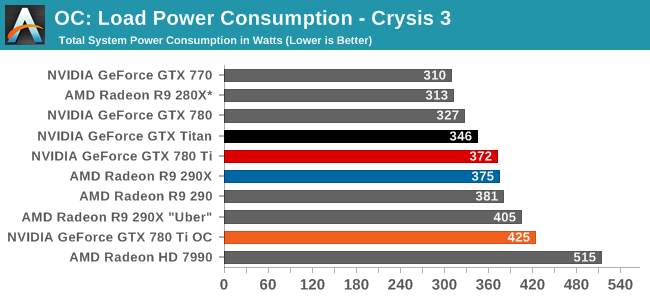
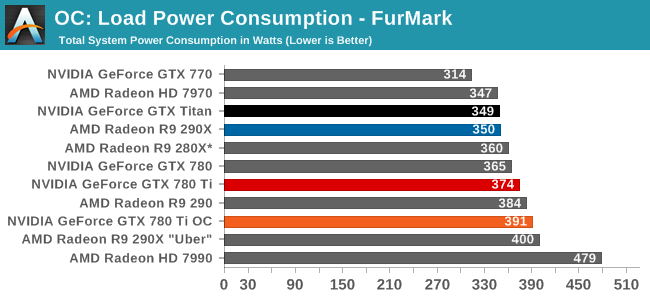
Starting as always with power, temperatures, and noise, we can see that overclocking GTX 780 Ti further increases its power consumption, and to roughly the same degree as what we’ve seen with GTX 780 and GTX Titan in the past. With a maximum TDP of just 106% (265W) the change isn’t so much that the card’s power limit has been significantly lifted – as indicated by FurMark – but rather raising the temperature limit virtually eliminates temperature throttling and as such allows the card to more frequently stay at its highest, most power hungry boost bins.
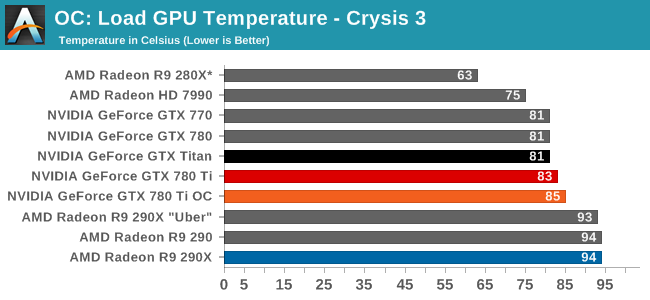

Despite the 95C temperature target we use for overclocking, the GTX 780 Ti finds its new equilibrium point at 85C. The fan will ramp up long before it allows us to get into the 90s.
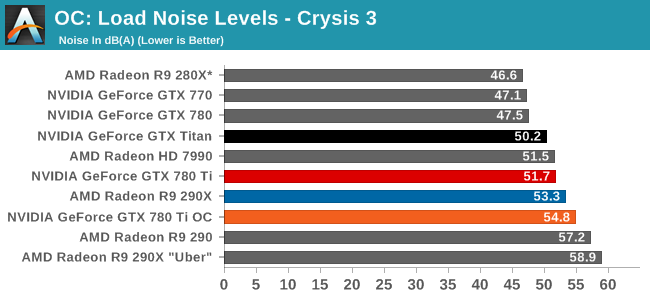
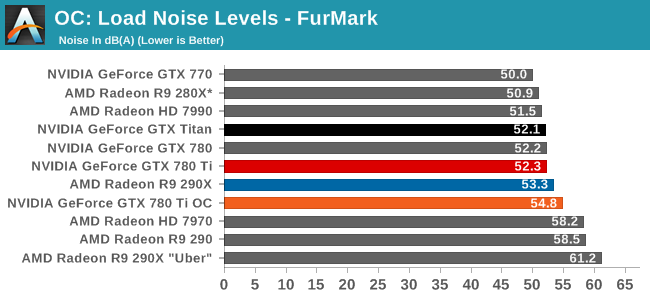
Given the power jump we saw with Crysis 3 the noise ramp up is surprisingly decent. A 3dB rise in noise is going to be noticeable, but even in these overclocked conditions it will avoid being an ear splitting change. To that end overclocking means we’re getting off of GK110’s standard noise efficiency curve just as it does for power, so the cost will almost always outpace the payoff on a relative basis.
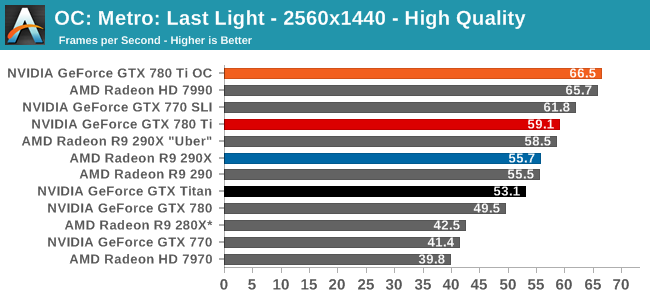
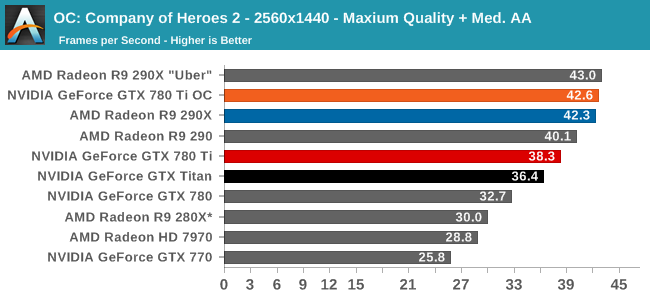
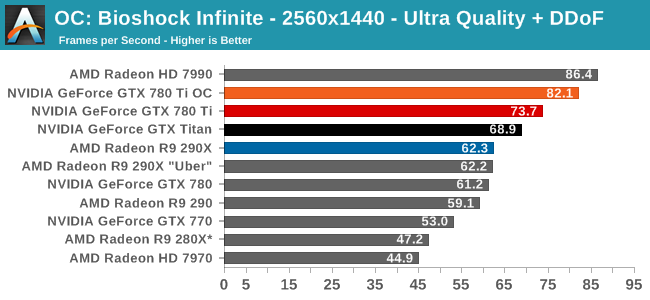
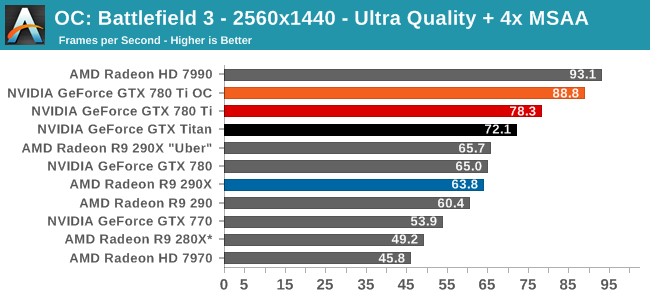
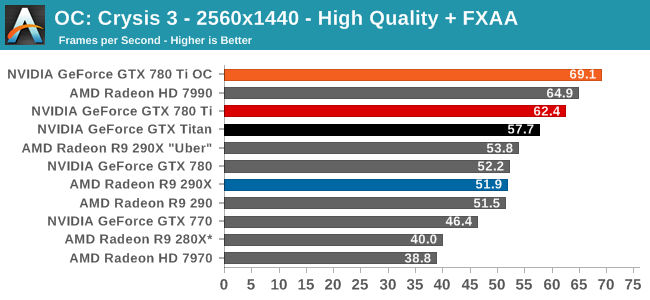
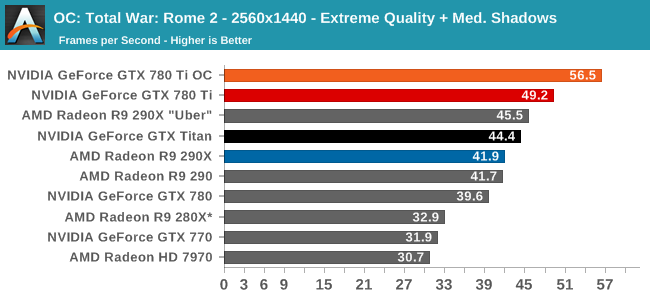
Finally, looking at gaming performance the the overall performance gains for overclocking are generally consistent. Between our 6 games we see a 10-14% performance increase, all in excess of the memory overclock and closely tracking the GPU overclock. GTX 780 Ti is already the fastest single-GPU card, so this only further improves its performance lead. But it does so while cutting into whatever is above it, be it the games where the stock 290X has a lead, or multi-GPU setups such as the 7990.










302 Comments
View All Comments
Kamus - Thursday, November 7, 2013 - link
I wouldn't buy that aftermarket cooler just yet.... I was about to buy one when I read that it's not cooling the VRM properly. Some guy bought 2 of them for his crossfire setup and started hearing whine from both cards. He concluded it was the crappy heatsinks that they provide for the VRM aren't up to the task.The VRM was exceeding 100 degrees. This resulted in games crashing and the loud whine I mentioned earlier. In the end, he put the regular AMD heatsinks back on, and that fixed the problem. Then he sold both cards and now he says he might just get regular 290's when they ship with custom coolers. Which isn't a bad idea at all, since those will probably outperform the reference 290x easily, for a lot less cash.
Margalus - Friday, November 8, 2013 - link
so in other words, you have to spend another $100 for an aftermarket cooler to make the 290 a reasonable card?milli - Thursday, November 7, 2013 - link
All you need is an Accelero Xtreme III. It proves that as soon as companies like HIS release better versions, the R9 cards will be silent, fast and cheap. I have a HIS HD 7950, a supposed loud card, that is completely silent.http://www.computerbase.de/artikel/grafikkarten/20...
Sivar - Thursday, November 7, 2013 - link
I gather from the link that you natively speak German. Please note that, in English, "silent" means "absolutely no sound". I think the word you are looking for is "quiet". :)HisDivineOrder - Thursday, November 7, 2013 - link
True, when custom cooled cards come out, that'll be great. None are announced and as far as I know no one's seen any. So you're waving your hands right now and saying, "When better cards come out, they'll be better!"You're talking about unannounced things you expect will come and save the day. I could easily say that overclocked variants of the 780 Ti are going to come and make everything better. Or that the GHZ editions of the 780 (non-Ti) are going to show up and magically make the price point logical again.
But you know what? I'm waiting until what I think MIGHT happen actually DOES happen. Rather than daydreaming about HIS coolers or MSI coolers or Gigabyte Windforce coolers on the R9 series when they haven't shown anyone a sign of such a card yet. Are they coming? Sure, yeah, someday. Are they coming in 2013?
...No one's seen one yet. Hell, there's more evidence of GHZ versions of the standard 780 than there are of custom-cooled R9 290/290x cards...
OverclockedCeleron - Thursday, November 7, 2013 - link
... and your point is? You are happy with a 700-dollar-card, then good for you. I was only speaking up because I have noticed a significant rise of anti-AMD trolls (i.e. Nvidia PR Reps). Just read the first comment to this article and tell me you don't see anything wrong with it.So you like logic and you think you got it all sorted? Well, how about this: Try to judge the silicon and not the fan, i.e., install equally superior GPU air-based coolers, and then Overclock each card to the maximum stable overclock, and re-run the benchmarks. I know who will win, but I am not here to preach or daydream like you said.
The point is, just because I realize the *actual* and *real* potential of something doesn't mean I am a daydreamer, it just means I appreciate that piece of silicon (i.e. R290X) and I realize that it is superior to the 780 Ti if it was not for that cheap heatsink.
TheJian - Thursday, November 7, 2013 - link
You're wrong unless you're saying NV will win after both are equipped with equal cooling and also, Superclocked 780TI has already been announced :)http://videocardz.com/47777/evga-launches-geforce-...
https://www.evga.com/articles/00795/#2884
1006/1072 out of the box. Dual classified has yet to be clocked. But would have to be faster than ACX version and they already have announce the water block model :)
03G-P4-2889-KR GTX 780 Ti Dual Classified w/ EVGA Hydro Copper
Currently you void your warranty pulling this on 290x or 290 right? Sure seems like OEM's have no trouble modding NV. I'm guessing AMD has to sort out this variance stuff before the OEM's can jump on board.
Realizing AMD is getting beaten doesn't make you an NV PR troll...LOL. This doesn't mean AMD's silicon is junk, just it's beaten. I for one am glad they released it forcing NV's full SMX hand. That means we can all look forward to even better 20nm chips as they now have a much higher bar to beat on both sides. I own a radeon 5850 BTW, because I realized it was the best silicon when I bought it (8800GT before that). I go wherever the SILICON/features tells me. The 8800GT is still serving my dad's pc from 2007 (over 6yrs old!). I'm wondering if these 95C chips can make it that long ;) My 5850 will be serving him the second I get my hands on 20nm maxwell (if only for gsync unless NV's chip totally sucks).
Galidou - Thursday, November 7, 2013 - link
No need to be a genius to KNOW that the custom cooled cards will be WORLDS above this even if they are not out. If you did not realise how crappy that cooler is, it was crappy for 7970 cards and it's the sAme... Comon, a little more than 90 IQ is necessary to find out about that...Toxicsix - Thursday, November 7, 2013 - link
More for less you say... Let's look at that. The 290X excels at 4K gaming and that's what AMD keeps cramming down our throat, how superior there product is at the highest resolutions. So If your looking at price performance you need to pair that 290X with a 4K display. Now let's look at some simple numbers shall we. 290X $5-600 + 4K Display $3k+ so your sitting at about $3500+ to get that top end performance. On the other hand you can spend $700 on a 780 Ti and pair it with an amazing 1080p monitor for well under 1k and the 780ti will stop all over Your 290X. Now your probably thinking that this isn't a "fair" comparison but you have to consider that the resolution is where these companies are going to try convince you that there card is superior. As it stands the 780 Ti is the King of 1080p gaming and it pisses me off big time that anadtech didn't even include 1080p benchmarks as this is where the majority of gamers are. If you want the best gameplay possible I would recommend getting the sweetest 1080p monitor you can find that will give you great refresh rates, low input lag and 3D capabilities if that's your thing and pair it with the fastest 1080p gaming card you can find which is now Nvidia's 780Ti. AMD has a great card in the 290X but we can't just look at price/performance based on the card alone we have to consider what were playing it into and look at the complete package as one.Fan_Atic - Thursday, November 7, 2013 - link
I hate to say it but most of your points are completely moot. The reason no one runs 1080p benchmarks in these reviews is that it doesn't stress a modern card. Anything above the $200 price point can pull 60 FPS at max settings any more. No one in their right mind would spend $700 for a graphics card to play at 1080p when a $250 can provide a 60fps experience with the same settings. 1440p 1600p and 4k are the only things that remotely stress modern mid to high end graphics cards.